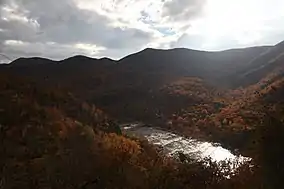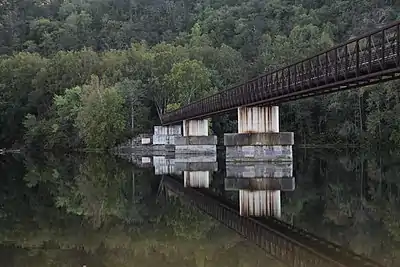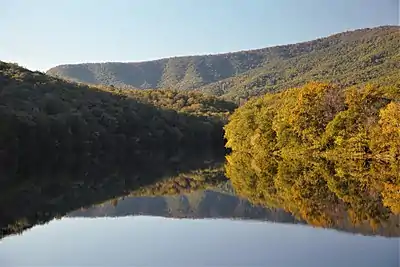James River Face Wilderness
The James River Face Wilderness is an 8,907-acre area located near Natural Bridge, Virginia that is protected by the Eastern Wilderness Act of Congress to maintain its present, natural condition. As part of the National Wilderness Preservation System, it helps to preserve a variety of natural life forms and contributes to a diversity of plant and animal gene pools. Over half of the ecosystems in the United States exist within designated wilderness.[1]
| James River Face Wilderness | |
|---|---|
IUCN category Ib (wilderness area) | |
 James River Face, from Va 130 looking southeast | |
 | |
| Location | Bedford, Rockbridge County, Virginia, United States |
| Nearest city | Buena Vista, Virginia |
| Coordinates | 37.588524°N 79.444885°W |
| Area | 8,907 acres (3,605 ha) |
| Established | 1975 |
| Administrator | U.S. Forest Service |
The wilderness contains many contrasting features. A short distance separates scorched hillsides, stark rockpiles and dry forest on one side and exceedingly rich vegetation on the crest of the Blue Ridge on the other.[2]
The area is part of the Glenwood Cluster.
Location and access

James River Face Wilderness is located in the Jefferson National Forest several miles from Natural Bridge Station, Virginia. It is bounded on the northeast by the James River, on the west by Forest Service Road 35, and on the south by the Blue Ridge Parkway.[3]
There are several well maintained trails giving access into the wilderness. Among these are:[3][2][4]
- Appalachian Trail, 9.9 miles, 2400 feet elevation change, trailheads on US 130 and FS 35[5]
- Balcony Falls Trail, 4.1 miles, 1850 feet elevation change, trailhead on FS 3093
- Belfast Trail, 2.8 miles, 1700 foot elevation change, trailhead on FS 35
- Gunter Ridge Trail, 5.1 miles, 1560 foot elevation change, trailhead FS 54
- Piney Ridge Trail, 3.5 miles, 1720 foot elevation change, trailhead on FS 54
- Sulphur Springs Trail, 2.7 miles, 1050 foot elevation change, trailhead on FS 35
Natural history
The forest cover includes chestnut oak and various types of yellow pine. Northern red oak and hickories are found near Highcock Knob. The wilderness has sheltered coves with white oak, basswood and tulip poplar. Old growth trees are found in the watershed of Matt’s Creek and along the James River where the Appalachian Trail goes into the drainage of Matt’s Creek.[6]

The Allegheny woodrat has been observed in the wilderness at the rock outcrops of the Devils Marbleyard.[7]:127 The population of the woodrat is in decline. Among the hypotheses being considered for the decline are the loss of food sources, loss of habitat and mortality from parasites introduced by raccoons.[7]:25–30
The lower elevations of the wilderness have a long history of mineral development and logging. The area contains the former Francis T. Anderson's Glenwood Estate, regarded as one of the finest principalities in western Virginia. Anderson operated the Glenwood Iron Furnace, an enterprise that required thousands of acres of timber to produce the charcoal used in the iron furnace. The area was stripped of its timber, and then operators returned to log second and third-growth timber.[2]
Topography

The wilderness has a complex topography with a peak Highcock Knob towering at an elevation of 3100 feet over the James River at 650 feet, a rock outcrop Devils Marbleyard composed of quartzite boulders the size of a schoolbus, many creeks with rapid descents and waterfalls, and the tall ridges Piney Ridge on the east and Gunter Ridge on the west.[8][2][4] [6]
Management
This wilderness was designated by congress in 1975 and is managed by the U.S. Forest Service as a part of the Glenwood-Pedlar Ranger Districts of the George Washington & Jefferson National Forests.[8] There are some regulations to maintain the integrity of the area. For example, motorized equipment, motor vehicles and mountain bikes are prohibited, group size is limited to ten people, and limits are placed on camping.
The wilderness is being monitored for clean air, with special concern for visibility, water quality and vegetation. Sulfur compounds produce a haze reducing visibility, an acidification of streams and a leaching of nutrients from the soil, and ozone creates visible injury to plant leaves reducing plant growth. Pollutants are created by many sources over a large geographic region.[9][10][11]
Nearby wildlands
Nearby wilderness areas and wildlands recognized as one of Virginia's "Mountain Treasures" by the Wilderness Society are:[12]
See also
References
- "Why Wilderness?". Retrieved October 18, 2016.
- Bamford, Sherman (October 2014). 18 Wonders of Virginia. Richmond, Virginia: Sierra Club Virginia Chapter. ISBN 978-0-926487-79-6.
- "Lexington, Blue Ridge Mts [George Washington and Jefferson National Forests]". www.NatGeoMaps.com. Retrieved April 21, 2019.
- Steven Carroll and Mark Miller (1995). Wilderness Virginia. Lexington, Virginia: Old Forge Productions. p. 145. ISBN 0-9646692-1-8.
- "James River Face Wilderness Hike". www.HikingUpward.com. Retrieved April 21, 2019.
- "James River Face Wilderness". Virginia Wilderness Committee. Retrieved April 21, 2019.
- Peles, John D.; Wright, Janet (2008). The Allegheny Woodrat. New York, N. Y.: Springer. ISBN 978-0-387-36050-8.
- "James River Face Wilderness - General Information". Wilderness.net. Retrieved May 5, 2019.
- Revised Land and Resource Management Plan, Jefferson National Forest, Management Bulletin R8-MB 115A. US Department of Agriculture. January 2004. p. 2-44.
- "- Forest Service Air Resource Management Program". www.fs.fed.us. Retrieved April 21, 2019.
- "James River Face Wilderness". webcam.srs.fs.fed.us. Retrieved April 21, 2019.
- Virginia's Mountain Treasures, report issued by The Wilderness Society, May 1999
External links
- Wilderness.net - U.S. National Wilderness Preservation System Map
- Wilderness Connect, James River Face Wilderness
- Appalachian Trail Parking and Access Areas in the James River Face Area
- Map of Trails in the James River Face Wilderness
- Management Regulations for Wilderness
- George Washington & Jefferson National Forests
- Wilderness Society